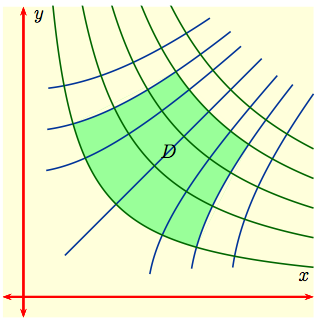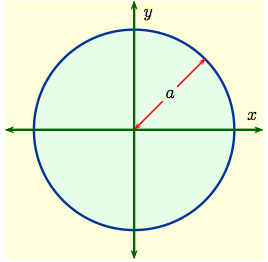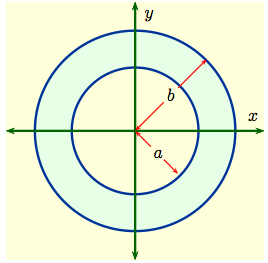Main page
Chapter 10: Parametric Equations and Polar Coordinates
Chapter 12: Vectors and the Geometry of Space
Chapter 13: Vector Functions
Chapter 14: Partial Derivatives
Chapter 15: Multiple Integrals
Learning module LM 15.1: Multiple integrals
Learning module LM 15.2: Multiple integrals over rectangles:
Learning module LM 15.3: Double integrals over general regions:
Learning module LM 15.4: Double integrals in polar coordinates:
Learning module LM 15.5a: Multiple integrals in physics:
Learning module LM 15.5b: Integrals in probability and statistics:
Learning module LM 15.10: Change of variables:
Change of variable in 1 dimensionMappings in 2 dimensions
Jacobians
Examples
Cylindrical and spherical coordinates
Mappings in 2 dimensions
Changing variables is a very useful technique for simplifying many types of math problems. You can use a horizontal translation $f(x) \, \to\, f(x+1)$ to change a parabola $y = f(x) = x^2 - 2x + 1$ with vertex at the $(1,0)$ into another parabola $y = f(x+1) = x^2$ with vertex at the origin. We also use changes of variables to convert hard integrals into easier integrals. The change-of-variables formula for ordinary integrals is $$ \int_a^b\, f(x)\, dx \ = \ \int_{\alpha}^{\beta}\, f\big(g(u)\big)g'(u)\, du\,, \qquad g : [\alpha,\, \beta] \ \to \ [ a,\,b]\,.$$
Transformations in higher dimensions, called maps or mappings, play an even more important role in multi-variable calculus. We have already seen one such mapping ${\bf \Phi} : {\mathbb R}^2\,\to\, {\mathbb R}^2$, namely polar coordinates: $${\bf \Phi}: (r,\, \theta)\, \to\, (x,\, y)\,, \qquad x \ = \ r\cos \theta\,, \quad y \ = \ r\sin \theta\,,$$
The reason mappings like these are so useful in double integrals comes from their action on particular sets in the plane.
|
Let's start with a general double integral
$$I \ = \ \int \int_D \,\, f(x, \,y)\, dx dy$$
over the green domain of integration $D$ in the $xy$-plane to the
right. For such a $D$ finding the limits of integration might well
be algebraically complicated, or the integration would be
algebraically difficult, or both would be.
Experience has shown that the integration would probably be much easier if $D$ were replaced by a rectangle with sides parallel to the coordinate axes. |
|
![]() A mapping ${\bf \Phi} : {\mathbb
R}^2\,\to\, {\mathbb R}^2$ and a rectangle $D^*$ with sides parallel to the axes in the $uv$-plane such that:
$${\bf \Phi}(u,\, v) \ = \ (x(u,\,v),\, y(u,\,v))\,,
\qquad {\bf \Phi}\big(D^*\big) \ = \ D\,;$$
A mapping ${\bf \Phi} : {\mathbb
R}^2\,\to\, {\mathbb R}^2$ and a rectangle $D^*$ with sides parallel to the axes in the $uv$-plane such that:
$${\bf \Phi}(u,\, v) \ = \ (x(u,\,v),\, y(u,\,v))\,,
\qquad {\bf \Phi}\big(D^*\big) \ = \ D\,;$$
![]() A 'distortion' function $\displaystyle{\frac{\partial(x,\,y)}{\partial(u,\,v)}}$ to replace $g'(u)$ so that
$$ \int\int_D \, f(x,\, y)\, dxdy \ = \ \int\int_{D^*}\, f\big({\bf \Phi}(u,\,v)\big)\, \left|\frac{\partial(x,\,y)}{\partial(u,\,v)}\right|\,dudv\,.$$
A 'distortion' function $\displaystyle{\frac{\partial(x,\,y)}{\partial(u,\,v)}}$ to replace $g'(u)$ so that
$$ \int\int_D \, f(x,\, y)\, dxdy \ = \ \int\int_{D^*}\, f\big({\bf \Phi}(u,\,v)\big)\, \left|\frac{\partial(x,\,y)}{\partial(u,\,v)}\right|\,dudv\,.$$
In this case, if $D^* = [a,\,b]\times[c,\,d]$, then $$ \int\int_D \, f(x,\, y)\, dxdy \ = \ \int_a^b \left(\int_c^d \, f\big({\bf \Phi}(u,\,v)\big)\, \left|\frac{\partial(x,\,y)}{\partial(u,\,v)}\right|\,dv\right)du\,.$$
When the region of integration $D$ in the $xy$ plane has rotational symmetry, polar coordinates often send a rectangle $D^*$ in the $r\,\theta$ plane to a more complicated region $D$.
|
Example 1: When $D$ is a disk of radius $a$ centered at the
origin, as shown to the right, then in $(x,\, y)$-coordinates
$$D \ = \ \bigl\{ (x,\,y) : x^2 + y^2 \ \le
\ a^2\,\bigl\}\,.$$
On the other hand, in the $r\theta$-plane $$D^* \ = \ \bigl\{ (r,\,\theta) : 0 \le r \le a,\ \ 0 \le \theta \le 2 \pi\,\bigl\}$$ is a rectangle. |
|
|
Example 2: When $D$ is an annulus centered at the origin between circles
of radius $a,\, b, \ \ a < b$ as shown to the right, then in $(x,\, y)$-coordinates
$$D \ = \ \bigl\{ (x,\,y) : a^2 \le x^2 + y^2
\ \le \ b^2\,\bigl\}\,.$$
On the other hand, in the $r\theta$-plane $$D^* \ = \ \bigl\{ (r,\,\theta) : a \le r \le b,\ \ 0 \le \theta \le 2 \pi\,\bigl\}$$ is a rectangle. |
|


